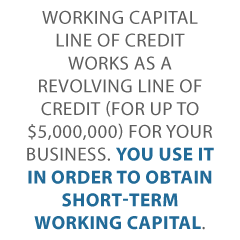You can get SBA credit lines. Yes, you!
The Small Business Administration wants your new small business to succeed. They know from experience that your business’s funding sources might not be perfectly reliable.
You might be looking for a trade line but cannot get one, at least for the time being. Your widget supplier might end up with a strike at the factory. The weather might make your vegetable supplier’s crop fail. Or your competitor might get to market first.
CAPLines
Whatever the reason you need credit, there are SBA credit lines which can help you to fund your small business. Four are through CAPLines.
Per the SBA: “CAPLines is the umbrella program under which SBA helps business owners meet short-term and cyclical working capital needs”. Loan amounts are on offer right up to $5 million. Loan qualification requirements are the same as with other SBA programs.
1 – Builders Line
This program can provide financing for small contractors or developers to construct or rehabilitate residential or commercial property for sale to a third party not known at the time construction and/or rehabilitation starts.
This line of credit can finance direct labor and material costs. The loans can be revolving or non-revolving.
Maturity for this loan is usually three years, but that can be extended for up to 5 years, if necessary, in order to facilitate the sale of the property.
Details
You must use the proceeds solely for direct expenses. These must involve acquisition, significant rehabilitation and/or immediate construction of residential or commercial structures.
You can include the purchase of the land if it does not exceed 20% of the proceeds of the loan. Plus you can use up to 5% of the proceeds for community improvements to benefit the overall property.
This type of loan is specially for general contractors or builders who construct or renovate residential or commercial structures.
Borrowers often use this type of loan in order to finance direct labor and material costs. In this instance, the building project serves as the collateral. Loans must not exceed 5 years.
2 – Contract Loan Program
A borrower can use this particular program to finance costs associated with contracts, subcontracts, or purchase orders. You can also use this kind of loan to finance direct labor and material costs associated with the performance of assignable contracts.
So this line of credit can be revolving or non-revolving.
The proceeds can be disbursed even before the work starts. If you use this loan for one contract or subcontract when all of the expenses are incurred before the purchaser pays, then the loan will generally not revolve.
Details
If the loan is used for more than one contract or subcontract, or if it is used for any contracts and subcontracts where the purchaser pays before all of the work is done, then the line of credit can revolve.
The maturity of this type of loan is generally based upon the length of the contract, but for no longer than 10 years. Contract payments often go directly to the lender. However, alternative structures are available.
https://creditsuite.wistia.com/medias/07p67s3ai0?embedType=async&videoFoam=true&videoWidth=640
3 – Seasonal Line of Credit
This program supports the buildup of accounts receivable, inventory, or labor and materials beyond normal usage due to the need for seasonal inventory. The loan advances against a company’s anticipated inventory and accounts receivables.
A company has to be in business for a period of at least twelve months. Also, it must be able to demonstrate it has a definite seasonal pattern.
Borrowers must use the loan proceeds only to finance the seasonal increases of accounts receivable and inventory. And in some cases these can be associated higher labor costs. This line of credit can be revolving or non-revolving.
Details
A business can use this type of loan repeatedly after a clean-up period of 30 days. So this is when a business can use it to finance a new season’s activity. The maturity for these kinds of loans can also be for up to 5 years.
The company might not have another seasonal line of credit outstanding. However, it can have other lines which it is using for its non-seasonal working capital needs. Maximum maturity for this line of credit is 10 years.
4 – Working Capital Line of Credit
This specific program works as a revolving line of credit (for up to $5,000,000) for your business. You use it in order to obtain short-term working capital. Businesses which usually use these lines will provide credit to their customers or they might have inventory as their primary asset.
This asset-based revolving line of credit is for businesses not able to meet credit standards associated with long-term credit. It provides financing for cyclical growth, recurring and/or short-term needs.
Details
Repayment comes from converting short-term assets into cash. This is then remitted to the lender. Businesses continually draw from this line of credit. So this has a basis in existing assets. Companies then repay as their cash cycle dictates. This line of credit is generally used by businesses which provide credit to other businesses.
Loan disbursements are generally based upon the size of a borrower’s accounts receivable and/or their inventory. Loan repayment comes collecting accounts receivable or selling inventory. There can be added collateral servicing and monitoring.
For this, the lender can charge the borrower additional fees. That is because these loans need continual servicing and monitoring of collateral. Maximum maturity for this line of credit is 10 years.
5 – SBA Express
Another option for SBA credit lines you can get to fund your business is SBA Express. You can also get a lesser loan amount more quickly using the SBA Express program. Many of these programs offer BOTH loans and revolving lines of credit.
SBA Express allows for loans of up to $350,000. Lenders and borrowers can negotiate the interest rate, which can be fixed or variable.
This rate has a tie to LIBOR, the option peg rate, or the prime rate. The Wall Street Journal publishes the latter. Also, the Federal Register publishes it quarterly.
The rate cannot exceed SBA maximums. Hence lenders can charge up to 6.5% over the base rate for loans of $50,000 or less. And they can charge up to 4.5% over for any loans over $50,000. No collateral is necessary for loans of $25,000 or less.
Details
An SBA Express Loan is guaranteed by the Small Business Administration for up to $350,000. There are not as many documentation requirements versus a more traditional 7(a) loan. These can also get funded more quickly.
These loans will typically have a 10 year repayment period.
The SBA will respond to an application within 36 hours. Funding is in 30 to 90 days. This particular financing program is flexible. So it can be used for working capital loans, a line of credit, or commercial real estate loans.
Specific terms are 5 to 10 years for working capital; 7 years for a line of credit; and 25 years for commercial real estate loans.
Collateral
There may be a collateral requirement. This will depend on the lender. Lenders do not have a requirement to take collateral for loans up to $25,000. However, they may use their existing collateral policy for loans of $25,000 to $350,000.
Standard Asset-Based Line
This line of credit is for companies not able to meet credit standards associated with long-term credit. Financing for cyclical growth, recurring and/or short-term needs. Repayment results from converting short-term assets into funds.
Businesses constantly draw from the line of credit, based upon preexisting assets, and repay as their cash cycle determines. This line typically is used by businesses that furnish credit to other companies.
Small Asset-Based Line
This is an asset-based revolving line of credit of as much as $200,000. This line operates like a standard asset-based line except for foregoing a few of the stricter servicing requirement. This is so long as the business can routinely show repayment ability from available resources for the total.
Bonus: Export Express
The SBA Export Express Program serves as a streamlined method. It is to get financing backed by the SBA for loans and SBA credit lines of up to $500,000. Lenders will use their own credit decision process and loan documentation.
Then the SBA provides an expedited eligibility review within 24 hours. A business must use the funds in order to enhance a business’s ability to export goods and services.
Export Express is a good option. So it’s good for businesses that need $500,000 or less in loans to start or expand an export business. The maximum loan amount is $500,000.
Details
Specific terms are: working capital loans: 5 to 10 years for maturity; SBA credit lines: 7 years for maturity; and real estate loans: 25 years for maturity.
When a lender submits a loan application to the SBA for approval, they will often respond within 24 hours. Actual funding time is 30 to 90 days.
Lenders and borrowers are able to negotiate the interest rate. Rates can be fixed or variable. They have a tie to a base rate. So this can be the prime rate, LIBOR, or the optional peg rate. Such rates may not exceed SBA maximums.
The maximums are up to 6.5% over the base rate for loans of $50,000 or less. And they are up to 4.5% over for loans over $50,000.
Collateral
Collateral gets its basis from any policies and procedures a lender establishes for loans it does not guarantee through the Small Business Administration.
Takeaways for SBA Credit Lines You Can Get to Fund Your Business
The Small Business Administration has SBA credit lines you can use to fund your business. Also, there are a variety of options to choose from. As with all forms of credit, be responsible and pay it back on time or early.
If your business needs funding, the Small Business Administration is one very viable option. Today we want to know what you think about SBA credit lines you can get to fund your business.

